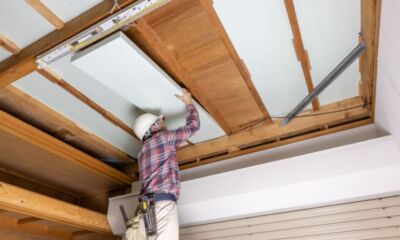How much does roof insulation cost?
If you’re tired of experiencing uneven temperatures inside your house, or the high utility bills that come with them, then roof insulation might be for you.

If you’re tired of experiencing uneven temperatures inside your house, or the high utility bills that come with them, then roof insulation might be for you.
KEY POINTS
- Roof insulation helps reduce heat loss or gain by up to 35%, cutting energy bills by as much as 45%.
- Installation costs depend on the insulation type, roof size, and labour, with professional rates typically between AU $40 and AU $150 per hour.
- Hiring a professional ensures safe installation and compliance with building regulations, making it a better choice than DIY.
How much does roof insulation cost?
Insulation is a layer of material installed in your roof, designed to help keep your home warm in winter and cool in summer.
The cost of roof insulation can depend on factors such as the type of insulation, the size of your home and your location. Trade listings website Servicetasker estimates between $1,200 and upwards of $5,000 to add insulation to your home, depending on the size of the job and materials used.
To help you get a better idea of how much insulating your roof might cost based on its size, hipages estimates $50-$70 per square metre for installation.
When it comes to buying materials, insulation can generally be bought either per square metre or per roll. For example, reflective sarking (a foiled layer of flexible insulation) can cost $3 per square metre, while glass wool batts (pre-cut insulation made of glass fibres bound into a texture similar to wool) can cost $6-$10 per square metre.
The type of insulation you choose can play a huge part in determining the cost, as each material will differ in price. For example, Melbourne based installer Climate Control Insulation estimates that polyester batts (a more eco-friendly and durable option) can cost $8 – $12 per square metre, while reflective foil insulation, often preferred in hot climates, can cost $7 – $16 per square meter.
For bulk purchases, hipages estimates the average price for bulk fibreglass costs between $600 and $1,000 per 100 square metres, while polyester-based products increase to an average of $1,100 to $1,500 per 100 square metres.
Factors that affect the price can include:
- The thickness or R-Value of the insulation material.
- The conditions for installers, such as the roof cavity being too hot, cold, cramped and/or dirty.
- Obstacles in the roof blocking accessibility.
- Uneven spacing across ceiling joints. Generally, the more uneven, the more time it will take to install.
Types of roof insulation
The two main types of insulation are:
- Bulk insulation like fibreglass wool, sheep wool, polyester and stone (rock) wool
- Reflective insulation, with the most popular example being reflective foil insulation.
Wool insulators are typically lightweight and produced in thick rolls or pieces known as batts. These fibrous materials have pockets of air between them, which blocks summer heat from entering through the roof and stops warmth escaping in winter months. It’s important to note that protective equipment is often required when installing fibreglass batts, due to risks of particle inhalation and/or skin irritation.
For irritation-free alternatives to glasswool, polyester has become an increasingly popular option. It’s often made from up to 85% recycled polyester and comes in a loose form or pellets that are usually blown into a roof or ceiling cavity. This installation method also includes foam-like insulators. This makes for a quick installation with excellent coverage.
The most costly insulation option is stone wool (also called rockwool) made from volcanic rock. It has superior acoustic and thermal insulating properties and is highly fire resistant. It doesn’t absorb moisture and is also resistant to mould, pests and corrosion.
Reflective insulation is the most basic form of insulation. Often produced as a foil, it’s usually installed under the roofing surface, where it reflects heat or cold away from the home interior. Reflective foil is most effective in warmer climates, where heat penetration into a roof cavity is the primary concern.
What is R-value?
When looking at different types of insulation, a common term that pops up is ‘R-value’. R-value is a rating that determines how effective a material is at preventing heat loss or gain. The higher the R-value, the better the thermal performance, which is typically why products with a higher R-value are more expensive. The R-value may also vary depending on the method of installation.
R-values can range from 1.5 to 7.0. Figuring out the best R-value for your needs depends on what suits your home and the climate in your area. For example, if your climate is quite hot, a lower R-value may be suitable. In colder climates a higher R-value (5.0-6.0) may provide more comfort in winter months.
Can you DIY roof insulation?
While roof insulation costs can be high, attempting to DIY the job without taking proper safety precautions is not advised. Entering the roof space can be extremely dangerous especially when dealing with electricity; electrocution is one of the biggest risks, caused by live wires coming into contact with foil-backed insulation.
Besides the safety hazards, there are regulatory requirements when it comes to installing insulation. Bulk insulation, reflective foil insulation and all electrical encased in insulation must meet Australian standards and all listed requirements. To find out more information, refer to Standards Australia.
If you have downlights, YourHome also advises that they can potentially cause ceiling fires when in contact with insulation. It recommends taking care when installing insulation; ensuring minimum clearances around downlights are maintained and that insulation isn’t covering any electrical devices such as transformers.
In terms of professional labour costs, Hiretrades.com.au says the “average labour cost to insulate a house can range from $50 to $80 per hour”. Professional installers can often work fast and efficiently so it may be relatively affordable to get professional installation. Additionally, while installers do not have to be licensed to fit insulation, they do need to follow other requirements and laws.
However if you are determined to install it yourself, Better Homes & Gardens recommends making sure you buy the correct width of material to suit the gap between your ceiling joists and to leave a gap around any light fittings to avoid heat build-up and reduce the risk of fire.
How to finance your roof insulation project?
How you choose to pay for your roof insulation will depend on your budget and the total cost of the project. A straightforward option can be to use your savings, allowing you to avoid interest charges or ongoing repayments on a loan.
If you don’t have enough savings, or prefer not to pay upfront, you may be able to tap into your home loan to fund the project. If you have an offset account or redraw facility linked to your mortgage, you could consider using the extra funds available through these features to cover your insulation costs. Just keep in mind that dipping into these funds may impact your long-term loan progress, as it can reduce the extra repayments you’ve made and extend the life of your loan.
If you’ve built up enough equity, refinancing your home loan to borrow additional funds could also be an option. But remember, any extra funds you borrow will need to be repaid, and refinancing may come with additional fees and charges.
Another option could be to pay using a personal loan or credit card. Personal loans can offer lower interest rates compared to credit cards and may come with either fixed or variable repayments, depending on the type of loan you choose. A credit card might be useful for smaller expenses—especially if you can repay the full amount within the interest-free period or take advantage of rewards points. But be mindful of the fact that carrying a balance on your card over time can lead to high interest costs.
Is roof insulation worth it?
If you’re using an air conditioner or heater and your home isn’t insulated, you might be wasting more money than you realise. Insulation can help keep your house cooler or warmer, depending on your situation, and potentially save you up to 45% on your electricity bills. Though that can sound tempting, it may be best to first consider all of the factors before deciding on whether roof insulation will be your next possible home improvement, such as:
- Installation costs
- Short-term energy and electricity savings
- Long-term savings (will it save you more than what you spent?)
- Available government rebates.
The comparison rate for all home loans and loans secured against real property are based on secured credit of $150,000 and a term of 25 years.
^WARNING: This comparison rate is true only for the examples given and may not include all fees and charges. Different terms, fees or other loan amounts might result in a different comparison rate.

Up to $4,000 when you take out a IMB home loan. Minimum loan amounts and LVR restrictions apply. Offer available until further notice. See provider website for full details. Exclusions, terms and conditions apply.
 Owner occupied
Owner occupied
 20% min deposit
20% min deposit
 Redraw facility
Redraw facility
 Owner occupied
Owner occupied
 20% min deposit
20% min deposit
 Redraw facility
Redraw facility
 Owner occupied
Owner occupied
 30% min deposit
30% min deposit
 Redraw facility
Redraw facility
 Owner occupied
Owner occupied
 30% min deposit
30% min deposit
 Redraw facility
Redraw facility
Canstar may earn a fee for referrals from its website tables, and from Sponsorship or Promotion of certain products. Fees payable by product providers for referrals and Sponsorship or Promotion may vary between providers, website position, and revenue model. Sponsorship or Promotion fees may be higher than referral fees. Sponsored or Promoted products are clearly disclosed as such on website pages. They may appear in a number of areas of the website such as in comparison tables, on hub pages and in articles. Sponsored or Promoted products may be displayed in a fixed position in a table, regardless of the product’s rating, price or other attributes. The table position of a Sponsored or Promoted product does not indicate any ranking or rating by Canstar. For more information please see How We Get Paid.
This article was reviewed by our Finance Editor Jessica Pridmore before it was updated, as part of our fact-checking process.

Before moving into finance, Vidhu went to law school where she studied human rights law. She has a Bachelor of Law degree and has previously worked in asset finance for Clifford Chance for more than four years. During her time at Clifford Chance, she worked in the India, London and Hong Kong offices on everything from aviation to vessel finance. In her spare time, Vidhu enjoys keeping up with the latest financial trends and spending time with her dog, Coco. You can connect with Vidhu on LinkedIn.
The comparison rate for all home loans and loans secured against real property are based on secured credit of $150,000 and a term of 25 years.
^WARNING: This comparison rate is true only for the examples given and may not include all fees and charges. Different terms, fees or other loan amounts might result in a different comparison rate.
 Owner occupied
Owner occupied
 30% min deposit
30% min deposit
 Redraw facility
Redraw facility
Try our Home Loans comparison tool to instantly compare Canstar expert rated options.
The comparison rate for all home loans and loans secured against real property are based on secured credit of $150,000 and a term of 25 years.
^WARNING: This comparison rate is true only for the examples given and may not include all fees and charges. Different terms, fees or other loan amounts might result in a different comparison rate.





